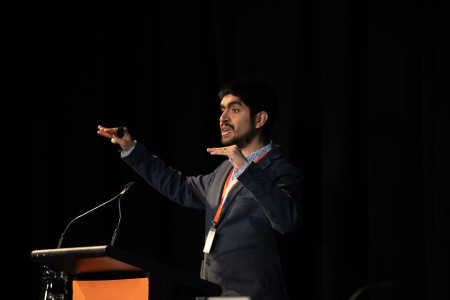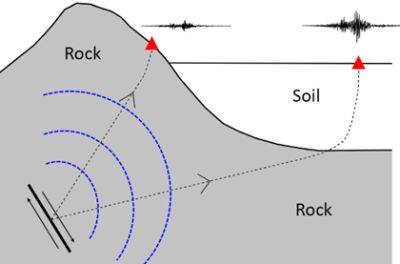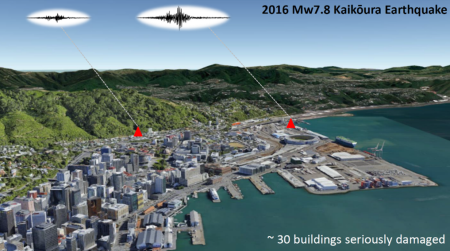Soil and small earthquakes help pave way for more resilient buildings
Analysing hundreds of small earthquakes is helping researchers predict how earthquakes could impact people’s homes and other buildings, depending on the soil beneath them.

Felipe Kuncar presenting his work at last year’s QuakeCoRE Annual Meeting.
University of Canterbury’s researcher Felipe Kuncar is working on a ground-motion simulation model that will improve understanding of how different neighbourhoods are impacted by shaking to better inform engineers and make buildings more resilient to large earthquakes.
Kuncar has been using data from the dense Christchurch network of 20 strong motion sensors (accelerometers) to analyse localised seismic activity. In the next few months, the PhD candidate expects to include more than 50 of these instruments from across Aotearoa New Zealand in his analysis, and says the modelling technique could be used to improve the seismic resilience of buildings all over the world.
By using a combination of data from frequent, smaller earthquakes with data from larger earthquakes too, the model can better simulate how a big earthquake would affect a neighbourhood, based on the make-up of their soil.

Local site effects of shaking - this diagram reflects how ground shaking can have different impacts, depending on the surface.
Dr Natalie Balfour, Head of Research at Toka Tū Ake EQC, which co-funded the research, believes this research is important for the future of resilient buildings in Aotearoa.
“We know different soils respond differently in earthquakes. It’s really exciting to be building this understanding about ground shaking at such a local level, it means we can plan and build smarter and be better prepared”, says Dr Balfour.
Fresh data from small earthquakes is fed back into the model, so it is constantly improved, which will enable engineers to design more resilient buildings for each type of soil.
“If we want engineers to use this modelling technique, they need to have confidence in it. Simulations are very complex, so the important step is to validate the computer simulations with real-life observations,” says Kuncar. He added that Christchurch offers a unique scenario as it has a high number of accelerometers producing large quantities of real data from big and small magnitude events.
Many Cantabrians are familiar with how soil can affect the impact of an earthquake. They witnessed first-hand how homes and buildings on softer soil were more affected than areas closer to the airport, where ground conditions were much more stable.

Demonstration: during the 2016 Kaikoura earthquake, areas of Wellington experienced shaking differently because of the soil. Near the waterfront (on the right) the soil was softer and deeper, thus shaking was felt more here.
Similar impacts were experienced in Wellington following the Kaikōura earthquake, where buildings on softer land, like those near Port, experienced more shaking than those on more solid ground.
"The soil is a softer material than the rock beneath it, and as a result it tends to amplify the ground shaking. We can compare this with a plate of jelly. If you shake a plate of jelly, the movement will be more severe at the top of the jelly than on the plate itself” says Kuncar.
“The soil has a significant impact on how we feel the ground shaking during an earthquake. The building code currently incorporates the soil, but only in a simplistic way. We hope to improve this practice, and think these simulations will be the future of earthquake resilient design.”
Kuncar would like to see the findings used for every new building and hopes to extend his research to Wellington, Napier and other regions where there is good data about the soil. He says this modelling approach could eventually be used all over the world.
“We’re proud to support this research by Felipe Kuncar, not only for his PhD, but also as the next frontier of seismic hazard analysis”, says Dr Balfour.
“We fund about $20 million in natural hazard risk and engineering related research each year to better understand our natural hazards, so we can support communities, local councils and decision makers to be better prepared by making more informed decisions.”
Kuncar’s thesis, ‘Modelling local site effects in physics-based earthquake ground-motion simulations’, was partially funded through the Toka Tū Ake EQC University Research Programme, in The Next Generation of Seismic Hazard Analysis for New Zealand led by Professor Brendon Bradley.